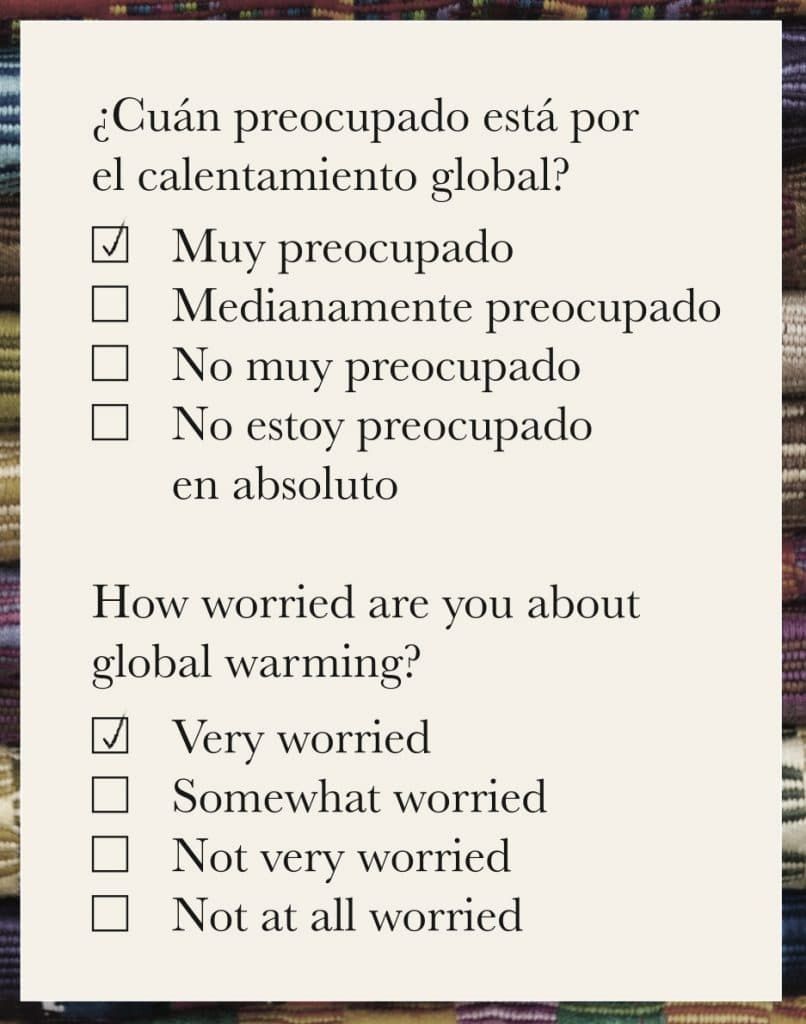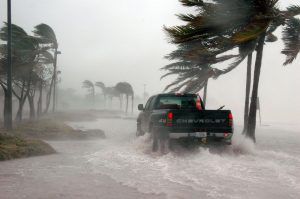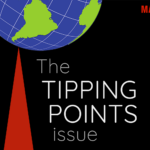What demographic group cares the most about climate change? Latinos, Yale researchers say.
By Dan Drollette Jr | August 25, 2020
 Image courtesy of Yale Program on Climate Change Communication.
Image courtesy of Yale Program on Climate Change Communication.
Since 2010, the head of the Yale Program on Climate Change Communication, Anthony Leiserowitz, and others in the social sciences have been studying how Americans and others around the world respond to the issues of climate change and other global challenges. They seek to find out what people understand and misunderstand about the causes, consequences and solutions of climate change; how they perceive the risks; and what kinds of policies do they support or oppose.
Through their research, researchers at the program hope to answer a central question: What are the psychological, cultural, and political reasons why some people get really engaged with these issues, others are kind of apathetic, and some are downright dismissive and hostile? And then they use those insights to inform what has essentially become their own climate news service, called Climate Connections—including feature articles, radio interviews, 90-second podcasts, monthly videos, and guest appearances by folks such as Bill Moyers. For the past seven years, they’ve been doing a national radio program with a brand new 90-second story about climate change every day, Monday through Friday; it currently plays on over 600 stations across the country.
In this interview, the Bulletin’s Dan Drollette Jr. asks about some of their more unexpected findings about who is most interested in fighting climate change, and what some reasons for that may be. (This interview has been condensed and edited for brevity and clarity.)
Drollette: I understand you folks have been doing research into how different sectors of the public accept—or don’t accept—the evidence for climate change, and the possible reasons why. I was hoping to ask you about the so-called “ethnicity gap” when it comes to accepting the evidence for the climate crisis. To give you some more background, a climate scientist named Dana Nuccitelli wrote a piece for us at the Bulletin of the Atomic Scientists (“A generation gap, when it comes to climate change”) which mentioned that ethnic minorities were much more likely than white Americans to support regulating carbon dioxide as a pollutant, citing a 2010 report that you had done with Karen Akerlof. Which stuck in my mind, because I haven’t run across this information elsewhere, and it’s the polar opposite of conventional wisdom.
Leiserowitz: That original report—now a decade old—was the first national study to look at the role of race and ethnicity in public responses to climate change. One of the big things we learned was that contrary to common wisdom, climate is not an issue that only white, well-educated, upper middle-class, latte-sipping liberals care about.
That’s just not true.
In fact, the racial and demographic group that cares most about climate change in the United States are Latinos. They’re far more convinced that climate change is happening, that it’s human-caused, and that policy actions must be taken to fight it. They’re much more engaged and supportive of efforts to fight climate change. That original study led to a whole series of additional studies that have increasingly tried to unpack some of these dimensions.
Drollette: Have you looked into this further? Can you tell me more about your findings?
Leiserowitz: Oh yes. We’ve actually looked into this quite a bit. Among other things, we did a partnership with the Gallup World Poll, studying public opinion about climate change in about 140 countries. And one big insight that came out of that collaboration was that people across Central and South America see climate change as a greater personal threat than people anywhere else—more than people in North America, Europe, Asia, Africa, or Australia.
And that was just remarkable. I mean, it’s not just Central and South America that experience the effects of climate change; people in Europe, Africa, India, and Asia have suffered from climate-induced storms, droughts, fires, and floods too. And this deep concern about climate change is true not just among Latinos in Central and South America, but among Latinos here in the United States as well. Our research found that Latinos as a community were far more engaged with this issue than any other racial or ethnic group in America that we can measure.
So that led to the obvious question: Why? What is it about one group that seems to make them so much engaged with this issue than another? And that’s still something we’re working through. You can see one of the latest studies about this angle (Climate Change in the Latino Mind) on our website.
Drollette: You said the most concerned group “that we can measure…”
Leiserowitz: That’s an important caveat. I’m not comparing Latinos to, say, Native Americans, because Native Americans are just such a small proportion of the population that it’s very difficult to get a large enough sample size for the purposes of a national survey. It’s not like we haven’t tried; I’ve done work with native peoples for many years, including among the Inuit Eskimo and in communities above the Arctic Circle in Northern Alaska. We have evidence that suggests they also are deeply concerned about this issue—but the sample sizes are just too small for a direct comparison.
So I’m singling out Latinos because we’ve been able to do direct comparisons there. I’m definitely not saying they’re the only large group that cares deeply about climate change, just that they’re the major demographic group we’re best able to measure. Latinos are at the top when it comes to concerns about climate change.
And the reasons for that turn out to be really complicated; there’s many factors involved. But at risk of over-simplifying, it seems to be cultural. There’s something about Latino culture that’s deeply rooted in a connection to—and a deep love, care, and concern for—the natural world.
This shows up in the way that Latino families are organized, the connections they have across generations, and the connections that relatively recent Latino immigrants to the United States maintain across wide expanses of geographic space with people in their home countries. Due to these very strong cross-border ties, there’s this direct connection to people in Central America who are suffering severely because of the impacts of climate change, for example, on an immediate and personal level.
I realize this is an inadequate explanation; there’s a lot more we need to know, but it’s just remarkable.
What all this ultimately means is that in many ways, the climate advocacy community must think about how to support Latino organizations and other organizations for people of color that are doing this climate work.
And also think about how to follow their lead.
Because this isn’t about persuading Latinos to be concerned about the environment. They’re already there, way out ahead of the white community. If anything, it’s more about following their lead than about trying to diversify one’s own organization.
Drollette: When you say that Latinos are leading the way, you mean that the Latino population is more inclined to accept the evidence for climate change and act on it?
Leiserowitz: Yes, I’m really talking about the populace. But strong, formally organized Latino climate and environmental organizations are starting to emerge as well, such as “GreenLatinos,” headed by Mark Magaña. I also think NextGen Climate has done a lot.
And then there’s Green Voices, or “Voces Verdes,” with the Natural Resources Defense Council. And the League of Conservation Voters has really stepped up its game in terms of engaging with climate-concerned Latinos, via its “Chispa” satellite organizations in Colorado, Arizona, Nevada, Florida, and Texas. Every single one of those states is potentially a critical swing state, so I think these Latino climate change organizations could have an enormous impact, in terms of national politics and ultimately, policymaking.
And from a purely political and pragmatic standpoint, Latinos constitute one of the fastest-growing demographics in the country. So, there’s many different reasons why Latinos deserve to be a part of the conversation in a stronger way than they have been.
And I think, frankly, that this is an indictment of not just the advocacy community, but the funding community: Latino green groups have simply not received adequate investments.
From a purely moral standpoint, they often represent communities that are particularly vulnerable to the impacts of climate change. So they should be at the table. Their voices should be heard.

Drollette: What about perceptions of climate change among other ethnic groups?
Leiserowitz: The other major group in the United States are the African-American communities, and there it’s more mixed. Although I think things have changed a fair amount in the past 10 years, because 10 years ago African-American’s really weren’t more engaged with this issue than, say, the white community.
Obviously I’m speaking broadly, about a national phenomenon. Because of course there are many African-Americans who have been leading the way—they in fact created the field of environmental justice. So our sense is that there’s a bit of a bifurcation within that community.
But we now do find that, for instance, African-Americans are more worried about climate change—more willing to get personally engaged and take action—than white Americans. In fact, we just released a short report about this, called “Which racial/ethnic groups care most about climate change” on our website, the Yale Program on Climate Communications.
Which reminds me—if you keep clicking through the Publications tab of the site, you’ll see a lot of different angles on the question of the level of acceptance of climate change evidence among different slices of society, and on the question of the desire to take measures to fight fight climate change. Because race and ethnicity is only one dimension of the issue. There are lots of others, including age differences and political persuasion.
Drollette: Speaking of which, is it true that America’s Republican Party is the only major political party that rejects the need to address climate change? From your studies of 140 countries, you folks must have a good sense of this.
Leiserowitz: Yes, it’s pretty much true. You could make a case for the conservatives in Australia taking that same stance, but they have not been as oppositional to action, shall we say, as the American Republican Party. That’s actually a critical finding that came out of our work with the Gallup World Poll, as well as the work of others in the social sciences: On a global scale, the United States is really an outlier, when it comes to climate change. There’s really only four major countries where you even find an organized denial movement: the United States, Australia, United Kingdom, and Canada.
Drollette: I notice they’re all English-speaking.
Leiserowitz: From what I’ve observed, the English-language component is really important because it makes it easy to import and export ideas and deniers. In fact, there’s a whole little lecture circuit with the same small stable of scientists trotting around from one meeting to the next, from the US to Canada, to Australia, to the UK, and back to the US—like a Borscht Belt for climate denialists.
And these countries share some underlying values and worldviews, which are really important drivers to how people respond to climate change. That is why Americans often perceive the science in such diametrically different ways.
Drollette: From your research, what are these drivers?
Leiserowitz: This is about more than being Democrat or Republican. This is about adherence to egalitarianism versus radical individualism.
Basically, egalitarians say that the government should be trying to eradicate the inequities of wealth within and across nations, because they are a major source of conflict. None of which has anything directly to do with climate change, but nonetheless people with that broad set of values are the same people who care most about climate change, because they see it as an issue of tremendous injustice and unfairness. They are concerned that the people who’ve benefited most from the burning of fossil fuels are not the people who are going to get hit first and worst. And so climate change a violation of the moral principles at the basic core of their identity in a really profound way.
On the flip side, the people who are most likely to be dismissive of the evidence for climate change are also much more likely to be adherents of this radical worldview that individual liberty is the one value that trumps all other values all the time: individual liberty, freedom, and autonomy always come first. And that’s usually framed as an anti-government position—that the government is too big and intrusive, with too much taxation and regulation. We all know this discourse very well; we’ve been steeped in it for a generation. That worldview sees government actions to deal with climate change as the real threat.
Drollette: So both sides actually see climate change as a threat, but for totally different reasons?
Leiserowitz: Egalitarians see climate change as a threat because they see its environmental impacts as a threat: rising seas, more frequent and intense heat waves, wildfires, floods, loss of native species, increased spread of tropical diseases, people forced from their homes, etcetera.
Meanwhile, the individualists see climate change as a threat to their core values and their preferred vision of society, because climate change is the mother of all collective action problems.
And stopping climate change is something that we can only do together. In fact, it’s the whole reason why we have a government in the first place, because that’s the only way we can take care of and solve big collective problems.
But if your worldview is “I want to shrink government to the size that I can drown it in a bathtub” as Grover Norquist memorably put it—then climate change feels like a direct threat to that.
In fact, it’s worse, because the solutions require not only collective action at the local level, state, or national level, but globally, among 190-plus countries.
And what’s the main institution we have to coordinate action across all those countries? The United Nations. Which is a real problem; for some of these radical individualists, when you say the phrase “United Nations,” they get visions of black helicopters in their heads. And they literally tell us in our surveys that when they think of global warming, they think it’s a United Nations’ plot to take away American sovereignty.
Drollette: Climate scientist Richard Somerville once did an op-ed along those lines for the Bulletin titled “How to deal with climate change denying Uncle Pete”. It said that some folks are convinced that any effort to stop, slow down, reverse, or mitigate the impacts of climate change is just an excuse to seize power and limit freedoms.
Leiserowitz: That’s a basic point we’ve been making from our research for about 12 years now: Climate change has joined sex, religion, and politics as issues that you shouldn’t talk about because you don’t want to piss off Uncle Pete. So yes, unfortunately, this is just part of the politicization of climate change.
And in addition to the political divide, there’s something else going on as well. I think what has made climate denial such a powerful force in these four countries is that it’s the combining of this strain of radical individualism with the enormous profit motive and power of the fossil fuel industry.
This is most perfectly distilled in the solitary figure of Charles Koch, who is both the head of the most profitable, largest, richest, privately held fossil fuel-oriented company in the world and a radical libertarian. And has used his billions from fossil fuels to build this incredible and very sophisticated political and communication machine to push his particular ideas, and gain more power within the Republican Party, for a generation.
It’s been an incredible story.
I’m just saying that you bring those two things together and it’s like nitrogen and glycerin: Put them together and you got yourself TNT.
Drollette: And we in the States have the most extreme, volatile version?
Leiserowitz: Our research shows we’re an outlier, for sure.
But even here, my sense from what we’ve picked up from our studies is that we’re seeing a wholesale shift in the underlying political, social and cultural climate of climate change. Fifteen years ago, this was an issue that was really only voiced by scientists, environmentalists, and a few liberal politicians.
That’s not true anymore, because the science has gotten more solid and, frankly, worrisome. The impacts are getting very clear and people are beginning to feel them directly. Meanwhile, all kinds of new voices are flooding into this conversation—as I mentioned at the beginning—which includes people of color and low income people, and the most marginal, and those hit first and worst. And it also includes lots of other voices, such as bankers, insurers, small-business people, big-business people, faith leaders like Pope Francis, and many others. It includes doctors and nurses who describe climate change as one of the biggest health risks facing the planet.
Drollette: But it still seems that there’s this misperception that climate change is the concern of just a few people. That the reality about who is concerned about climate change may be one thing, but the perception is different. Why is that?
Leiserowitz: It’s due to multiple things, such as this very sophisticated, extremely well-funded propaganda campaign to promote climate denialism. And I’m not using that word by accident; there have been concerted efforts to push out misinformation and disinformation about climate change. This strategy of doubt was lifted root and branch from the tobacco industry and used to great effect with climate change. That’s been exceedingly well-documented, and we see it in our data: Most Americans still have no idea that there’s an overwhelming scientific consensus that climate change is real and human-caused. The vast majority of Americans have no idea that the experts have reached that level of consensus.
And that’s not an accident. That was the result of a very concerted strategy by those interests I mentioned.
At the same time, climate change has suffered from being described as distant—distant both in time and in space. I mean, our research shows that most people still believe that the impacts won’t be felt for a generation or more. So if they’re worried about climate change, it’s in a more abstract way and put on the back burner—as in “Look, we got to worry about the economic crisis right now,” or “We’ve got to worry about coronavirus.” Those are things that are right here, right now. So the attitude is that “we can put climate change on the back shelf because it’s not going to be a problem for another 30 years.”
At least, that’s been the longstanding narrative. And as a result, it’s psychologically distant. It just becomes one of a hundred other issues to deal with.
Although now we’re finding that that perception has been changing dramatically in the past five years. It’s part of this overall, larger, shift in consciousness—if I can use the grandiose phrase—that’s been going on both in the United States and around the world right now.
But the underlying problem that as human beings, we’re just not well suited to deal with situations like this. Because this thing is invisible.
Drollette: So, the research shows that when you can’t see it, you just don’t perceive it as a problem?
Leiserowitz: Let me just put it this way: Right now, there’s carbon dioxide pouring out of tailpipes, out of buildings, and out of smoke stacks. But if you look out your window, you can’t see it. So you weren’t conscious of it, because it’s invisible.
So unfortunately, the fundamental cause of this problem is it’s just not something that we are as critters able to see. If carbon dioxide had been pink and was filling the air all around us, we would have dealt with it a long, long time ago.
One of the most effective campaigns ever done was on this very point, in the form of a TV ad campaign in Australia where black balloons were used to represent carbon emissions.
It’s an old ad, but very effective at helping you visualize what carbon dioxide is, where it’s coming from, and how everything you do is actually part of the problem.
Together, we make the world safer.
The Bulletin elevates expert voices above the noise. But as an independent nonprofit organization, our operations depend on the support of readers like you. Help us continue to deliver quality journalism that holds leaders accountable. Your support of our work at any level is important. In return, we promise our coverage will be understandable, influential, vigilant, solution-oriented, and fair-minded. Together we can make a difference.
Keywords: carbon dioxide, climate awareness, climate change, climate communication, climate crisis, global warming
Topics: Climate Change















